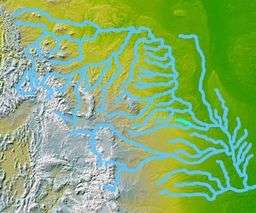Keya Paha River
| Keya Paha River | |
| River | |
| Keya Paha River near Nebraska-South Dakota border | |
| Country | United States |
|---|---|
| States | South Dakota, Nebraska |
| Source | Todd County, South Dakota |
| - coordinates | 43°13′38″N 100°23′18″W / 43.22722°N 100.38833°W [1] |
| Mouth | Niobrara River in Boyd County, Nebraska |
| - coordinates | 42°53′54″N 98°59′6″W / 42.89833°N 98.98500°WCoordinates: 42°53′54″N 98°59′6″W / 42.89833°N 98.98500°W [1] |
| Length | 127 mi (204 km) |
| Basin | 1,710 sq mi (4,429 km2) [2] |
 Keya Paha River in light green at right center | |
The Keya Paha River (/ˈkɪpəhɔː/ KIP-ə-haw)[3] is a river flowing 127 miles (204 km)[4] through the U.S. states of South Dakota and Nebraska.
The name is derived from the Dakota language ke'-ya pa-ha', meaning "turtle hill",[5] specifically Turtle Butte.[6] The river's name was given to Keya Paha County, Nebraska, through which it flows.[7]
The river originates in Todd County in south central South Dakota, at the confluence of Antelope Creek and Rock Creek near the town of Hidden Timber.[8] It flows in a generally southeasterly direction through Todd and Tripp counties in South Dakota and then through Keya Paha and Boyd counties in Nebraska.[1] It ends at its confluence with the Niobrara River about 7 miles (11 km) west of Butte, Nebraska.[9] The river has a year-round flow, except for winter ice, and has a quality of water better than all other South Dakota rivers.[10]
In 1861, the border between the Nebraska and Dakota territories followed the Keya Paha River from the 43rd parallel to the river's confluence with the Niobrara; it then followed the Niobrara to the Missouri. This situation lasted until 1882, when the boundary was changed to follow the 43rd parallel all the way to the Missouri;[11] the change added portions of Keya Paha and Boyd counties to Nebraska.[12]
Discharge
At a gaging station south of Naper in Boyd County, the river's mean discharge was 138.6 cubic feet per second (3.92 m3/s). The maximum mean annual discharge was 389.4 cubic feet per second (11.03 m3/s), recorded in 1962; the minimum mean annual discharge was 44.5 cubic feet per second (1.26 m3/s), recorded in 1976.[13] The peak flow recorded at that point was 9,280 cubic feet per second (263 m3/s), registered on July 1, 1962.[14] From July 22 to July 30, 1976, the discharge was recorded as zero.[15]
See also
References
- 1 2 3 "Keya Paha River". Geographic Names Information System. United States Geological Survey. 1979-03-09. Retrieved 2011-02-26.
- ↑ Seaber, Paul R., F. Paul Kapinos, and George L. Knapp (1987). USGS Hydrologic Unit Maps. U.S. Geological Survey Water-Supply Paper 2294. Cataloging unit 10150006, on p. 39. Retrieved 2011-02-26.
- ↑ McNally, Hannah, and Diana Lambdin Meyer (1997). Nebraska: Off the Beaten Path. Morris Book Publishing LLC. p. 81.
- ↑ U.S. Geological Survey. National Hydrography Dataset high-resolution flowline data. The National Map, accessed March 30, 2011
- ↑ Fitzpatrick, Lilian Linder (1925). "Keya Paha County". Nebraska Place-Names. Retrieved 2011-02-26.
- ↑ Federal Writers' Project (1940). South Dakota place-names, v.3. University of South Dakota. p. 4.
- ↑ "Keya Paha History". Nebraska Association of County Officials. Retrieved 2011-02-26.
- ↑ Carter, Janet M. (1998). "Water Resources of Mellette and Todd Counties, South Dakota". USGS Water-Resources Investigations Report 98-4146. Retrieved 2011-04-26. Map on p. 1.
- ↑ Nebraska Atlas and Gazetteer. Freeport, Maine: Delorme. 3rd edition, 2005. p. 23.
- ↑ Hogan, Edward Patrick; Fouberg, Erin Hogan (2001). The Geography of South Dakota (Third ed.). Sioux Falls, SD: The Center for Western Studies – Augustana College. ISBN 0-931170-79-6.
- ↑ Visher, Stephen Sargent (1918). The Geography of South Dakota. p. 11.
- ↑ Kay, John and Mary Findlay (1988). "Nebraska Historic Buildings Survey: Reconnaissance Survey Final Report of Boyd County, Nebraska". Nebraska State Historical Society. Retrieved 2011-02-26.
- ↑ Calculated from mean annual values for years 1958–1994 inclusive, found at "USGS 06464900 Keya Paha River Near Naper, Nebr." USGS Water Data for the Nation. Retrieved 2011-02-26.
- ↑ Peak flows for years 1958—1994 inclusive, found at "Peak Streamflow for Nebraska: USGS 06464900 Keya Paha River Near Naper, Nebr." USGS Water Data for the Nation. Retrieved 2011-02-26.
- ↑ Daily data for July 1–August 31, 1976, found at "USGS 06464900 Keya Paha River Near Naper, Nebr." USGS Water Data for the Nation. Retrieved 2011-02-26.